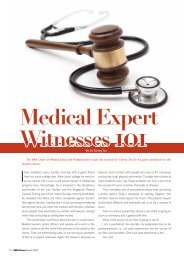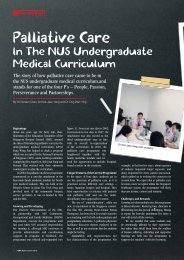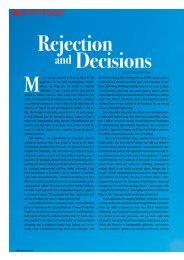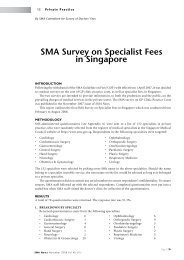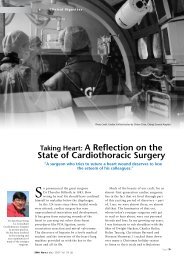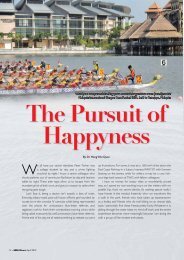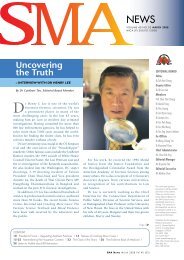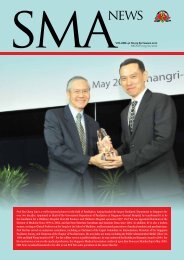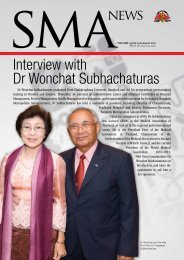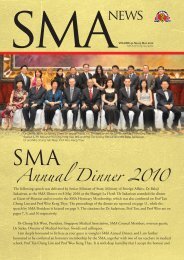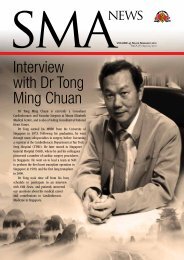Interview with Prof Woo Keng Thye - SMA News - Singapore ...
Interview with Prof Woo Keng Thye - SMA News - Singapore ...
Interview with Prof Woo Keng Thye - SMA News - Singapore ...
You also want an ePaper? Increase the reach of your titles
YUMPU automatically turns print PDFs into web optimized ePapers that Google loves.
kidney. In 1968, a chronic haemodialysis<br />
programme was established in the <strong>Singapore</strong><br />
General Hospital (SGH). In 1975, the first selfdependency<br />
dialysis unit (SDDU) was set up<br />
in Alexandra Hospital and in 1983 the second<br />
SDDU was set up in Tan Tock Seng Hospital.<br />
These are the subsidised state-supported<br />
haemodialysis programmes where patients<br />
were dialysed <strong>with</strong> the help of their spouses or<br />
relatives. In 1981, <strong>with</strong> the opening of the new<br />
SGH, a new dialysis centre was set up there.<br />
This remains as the main dialysis centre today,<br />
and patients <strong>with</strong> problems on dialysis at the<br />
National Kidney Foundation Centres or other<br />
centres are referred, including those requiring<br />
renal transplant workup.<br />
Continuous Ambulatory Peritoneal Dialysis<br />
(CAPD) was introduced in 1980 when five<br />
patients were enrolled in the programme. In<br />
1987, a CAPD unit was established in SGH to<br />
provide an integrated approach to patient<br />
training, management and education. By 1996,<br />
there were close to 400 patients in SGH and<br />
the National University Hospital. The peritonitis<br />
rate used to be about one in 27 patient months.<br />
Today <strong>with</strong> technical advances the peritonitis<br />
rate is one in 48 patient months. CAPD is an<br />
equally viable alternative to haemodialysis.<br />
Renal transplantation remains the ideal<br />
renal replacement therapy. The first cadaveric<br />
renal transplant in <strong>Singapore</strong> was performed<br />
in July 1970. Living related donor transplant<br />
has been performed since 1976. Since 1985,<br />
cyclosporine A was introduced and this has<br />
resulted in better transplant survival rates. The<br />
Medical Therapy, Research and Education Act<br />
was passed in Parliament in 1972. Under this<br />
Act, individuals can pledge or will their kidneys<br />
for transplant purposes in the event of death.<br />
Relatives of the deceased can also give consent<br />
for kidneys to be retrieved for transplantation.<br />
But until 1987, the average number of kidneys<br />
obtained was only five a year. Faced <strong>with</strong> this<br />
shortage of cadaver kidneys, the Human Organ<br />
Transplant Act (HOTA) was implemented in<br />
1988 and has resulted in a dramatic increase<br />
in the yield of cadaver kidneys.<br />
The bulk of the clinical service work<br />
is in the area of clinical nephrology <strong>with</strong><br />
glomerulonephritis constituting the major<br />
portion. Asymptomatic haematuria and<br />
proteinuria is the commonest presentation<br />
for patients <strong>with</strong> glomerulonephritis. This<br />
group of patients we now know have IgA<br />
nephritis, which is the most common form<br />
of glomerulonephritis seen in <strong>Singapore</strong><br />
and overseas. It is to the credit of the first<br />
generation nephrologists in <strong>Singapore</strong> that<br />
two years after the founding of the <strong>Singapore</strong><br />
Society of Nephrology, they organised the<br />
First Asian Colloquium in November 1974.<br />
The papers published included those on<br />
glomerulonephritis, urinary tract infection,<br />
acute renal failure, haemodialysis and renal<br />
transplantation.<br />
<strong>SMA</strong>: What are some of the exciting frontiers<br />
of nephrology?<br />
WKT: The three main pillars of in the practice<br />
of nephrology are in clinical nephrology,<br />
dialysis and renal transplantation. For clinical<br />
nephrology, we can now detect many types of<br />
kidney diseases at a very early stage and offer<br />
treatment before the disease causes harm. For<br />
those <strong>with</strong> established kidney disease, kidney<br />
damage and renal failure, we can now offer<br />
treatment to arrest the progression. For those<br />
<strong>with</strong> mild renal failure we can even reverse the<br />
situation <strong>with</strong> drugs currently available.<br />
Feature<br />
In the field of dialysis,<br />
what is awaited for most eagerly by many<br />
patients on dialysis is the Automated Wearable<br />
Artificial Kidney (AWAK). AWAK technology was<br />
incorporated in 2007 and dedicated to the<br />
development of wearable artificial kidneys. It<br />
was jointly founded by Dr Gorden Ku (Chairman<br />
of Kidney Dialysis Foundation) and the two<br />
chief scientists and inventors, <strong>Prof</strong> David Lee<br />
and Dr Martin Roberts from UCLA, USA. AWAK<br />
is based on the technique of peritoneal dialysis<br />
and sorbent based regeneration of used<br />
dialysate. It is both bloodless and waterless<br />
and provides round the clock dialysis and<br />
ultrafiltration, and represents the ultimate<br />
form of frequent dialysis, which provides a<br />
steady state of metabolic and fluid regulation.<br />
It weighs about two pounds and is battery<br />
<strong>SMA</strong> <strong>News</strong> december 2010 | 5




